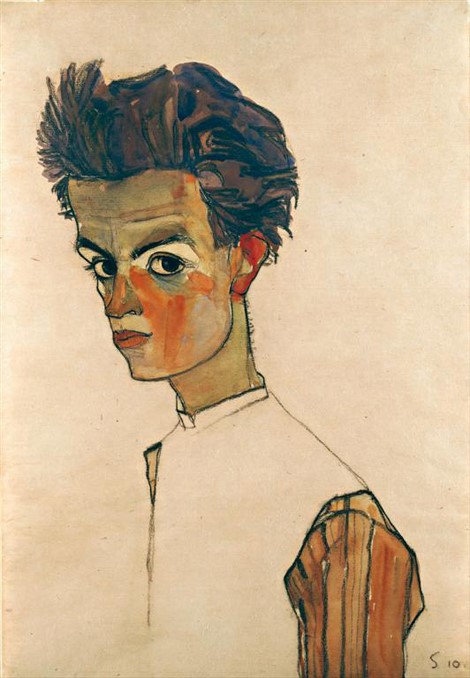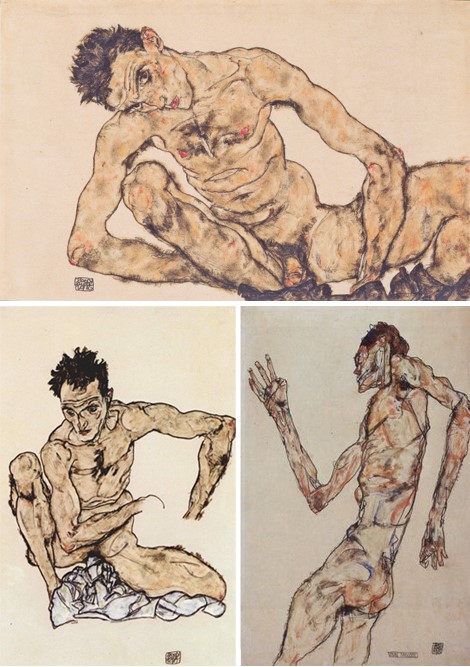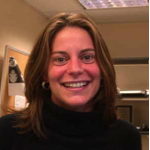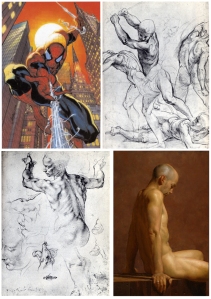For this week’s extended session of the Open Studio we will be having poses inspired by the life drawings of the Austrian artist Egon Schiele.
Born into a working class family in Lower Austria, Schiele was a shy child who drew constantly. Schiele did not do well at school. After losing his father at the age of fifteen, Schiele’s education was guided by an uncle, who, noticing the boy’s talent for art, allowed him a drawing tutor.
After passing through a couple of very strict art schools, Schiele sought out famous artist Gustave Klimt, a leader of the Viennese avant-garde. In Klimt, Schiele found a true mentor. The established Klimt encouraged the young artist, buying his work and arranging for exhibitions.
It would have been an unusual person who would have been able to get along with the odd and tempestuous Schiele, but Klimt was that person. The work of both the younger and older artist grew through their contact with each other.
Schiele was one of only a handful of artists to have elevated life drawing from a form of study to an art in and of itself. He did this through a precocious ability to juggle elements of rendering, design and expression simultaneously.
Usually when drawing from the living figure, an artist is so focused on ‘getting it right’ that the design of the sheet, the relationship of marks and paper to each other, go unconsidered.
But not with Schiele. For him placement was primary. Moving with ease between observation and abstraction, Schiele was able to take his teacher Klimt’s decorative innovations in composition and invest them with psychological depth.
Allied to his attention to the position of the figure on the paper, was Schiele’s interest in pose. Although Picasso, working in the advanced artistic milieu of Paris, was more radical in his re-ordering of the figure as he drew, Picasso did not come near to Schiele in exploring the expressive power of pose itself.
Schiele’s innovative exploration of the model’s pose highlights the great contribution made by models in the creation of art. The inward-looking Schiele did not arrive at the distinctive poses characteristic of his art on his own. Rather, it was his friendship with the dance team of Erwin Osen and Moa Mandu that awakened Schiele to the expressiveness of movement.
Schiele found the extravagant duo entrancing. Although he was primarily a linear artist, Schiele was inspired by Moa Mandu’s daring sense of style to create some of his most painterly work.
Moa’s dance partner and life-mate Erwin Osen was a mime. When the outrageous, out-going cabaret performer posed for Schiele, it must have seemed to the artist as if his intense, suppressed emotions had found their external form. He was to use the vocabulary of movement he picked up from the mine in most of his later works, many of them self-portraits.
Schiele’s life was as short as it was tumultuous. By 1918, he had been celebrated, reviled, jailed, conscripted, and survived a world war. He was newly married and about to be a father when the deadly Spanish flu swept through Europe. Klimt succumbed first. Then Schiele’s wife, Emily. Schiele died three days later. He was twenty-eight.
But he left a great legacy. In his few short years Schiele brought the decorative style of artwork from the late nineteenth century into the twentieth, laying the groundwork for Expressionism. His public display of the personal, the painful and sometime juvenile, has become the norm in the twenty-first.
For this week’s extended drawing session our model will be taking poses inspired by Schiele’s drawings.
This Wednesday’s session will run from 7-10pm with a series of short poses in the first hour, two medium-length poses in the second, and a single, long pose in hour three.
As always, you are welcome to attend for whatever combination of times works for your schedule.
The fee for two hours is $10; for three, $15.
Hope to see you there!
~ Ken Nutt, Open Studio





